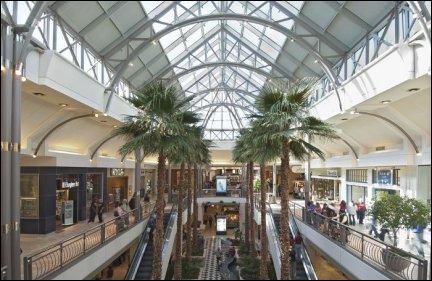The poor shopping mall. That once impenetrable fortress now seems as susceptible to the ailing economy as the rest of us. Vacancies are at an all-time high. Dead and dying malls continue to plague the landscape. And, perhaps worst of all, the mall has transformed from an icon of American life — see Fast Times at Ridgemont High — to a scourge, a symbol of the poor judgment of developers and the government policies that supported them. The mall, at this point, is not only unsustainable, it’s downright unfashionable, and not just for urban planning aficionados; regular old mall-loving Americans are abandoning it, too.
Luckily, mallternatives are popping up across the land, demonstrating new futures for these old fixtures. Some dinosaur shopping centers are being de-malled, a polite term for razing and rebuilding. Some, like Bridgewater Commons in central New Jersey, are cutting hours to save dough. Others are lowering rents to allow locally owned businesses to set up shop inside, dispensing with the chain-store-only exclusivity that once characterized them.
And in at least one case, a mall is in the process of morphing into a new being: a city.
 Tysons Corner developers are shopping a vision for the future.Fairfax County
Tysons Corner developers are shopping a vision for the future.Fairfax County
Tysons Corner Center, the largest shopping mall in metropolitan Washington, D.C., is doing just fine, thank you, says John Genovese, executive vice president of Macerich, the mall’s developer. But for the past six years, its creators have been dreaming of redeveloping it. “Tysons was very successful back in 2003 when we started this process, but we saw this opportunity to enhance it,” he says.
Tysons opened in 1968 as a traditional super-regional mall, drawing people from all over the area on the shiny new Beltway to big businesses like Woolworth and Hecht’s. In its current incarnation, it’s a 2.2 million-square-foot enclosed mall with five fancy anchor stores — Nordstrom, Bloomingdale’s, Lord & Taylor, Macy’s, L. L. Bean — as well as 300-plus other stores and restaurants and a 16-plex movie theater. It’s so popular that it’s a major cause of the notorious traffic surrounding the city that houses it, also called Tysons Corner (that, and the fact that there’s almost no way in or out of the city except by car).
That traffic is what prompted Fairfax County — which runs the city of Tysons Corner, since the latter is unincorporated with no centralized government of its own — to begin planning for the 23-mile extension of D.C.’s Orange Line that would add four Metrorail stations to this sprawling edge city. Thanks to a change in the area’s comprehensive plan, allowing density to almost triple, Tysons Corner Center could grow, up and out and differently.
In the next decade or so, the mall will increase to 3.5 million square feet. It will include a 300-room, 266,000-square-foot hotel, 200,000 square feet of retail, and 1.4 million square feet of offices. Most importantly, it will include 1.6 million square feet of residences, surrounded by green spaces, walking paths and recreational facilities like an ice rink, sculpture plaza, gardens and performance spaces. It will be a city unto itself, with a transit stop within walking distance to ferry people to and from the development.
“You’re [creating] almost a 24-hour nature to the property,” says Genovese, as opposed to a mall that deadens its lights and releases its patrons at 9 p.m. The 21st century mall is the opposite of an enclosed, super-regional bubble — a local, centralized creation with not just high-end chain stores but the little retailers that support residential life, like dry cleaners and grocers and shoe repair shops. The name of the project: Tysons Future.
Some of its parking lots will be transformed into streets, a central part of the new plan for the entire Tysons area. Currently, there are only a few busy roads in and out of the city, with private streets ending abruptly or spilling out into parking lots — the county wants to create a street grid throughout the city. While Macerich wants Tysons Corner Center to be as walkable, bikeable, and urban as possible, Genovese is realistic about the limits of transforming mall into city. When it comes down to it, there are limits to the plan. After all, as he points out, “We’re not going to run a street through Nordstrom’s.”


